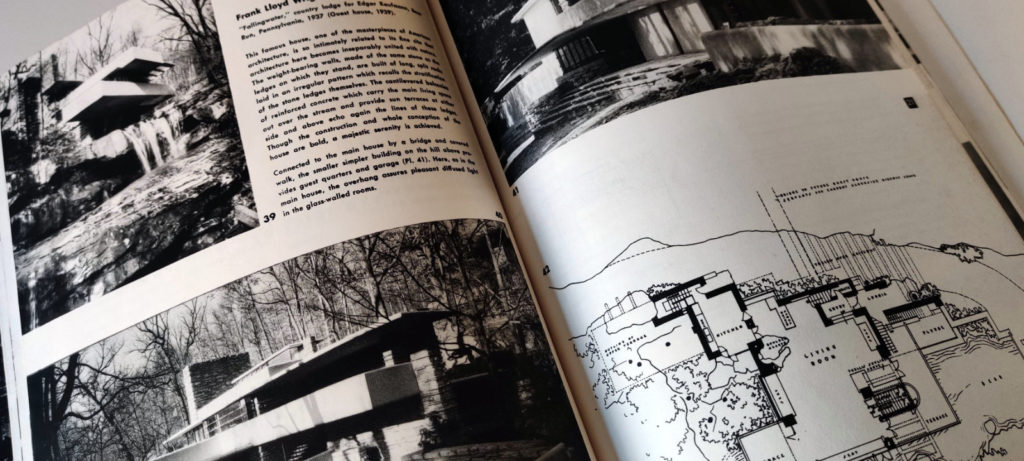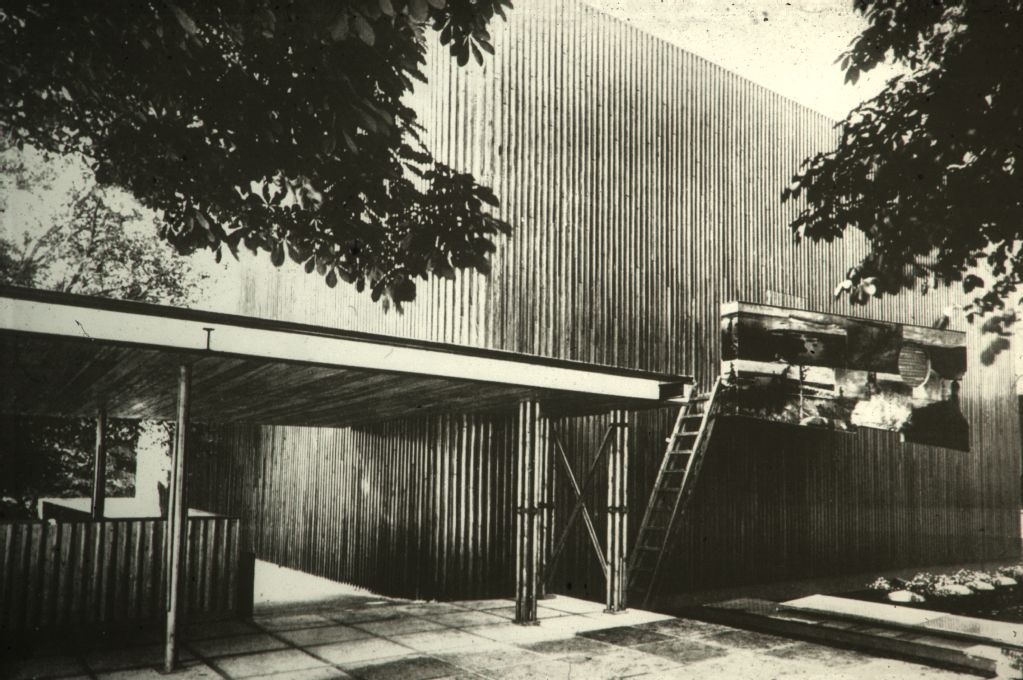Vintage Book of the Month: What is Modern Architecture? 23.05.2020 – Posted in: Book Thoughts
One of the greatest appeals of old books for me is that they open a window to another context. At best, reading an old text and looking at its illustrations is a ticket to time travel. This is what they thought was important at the time. This is how they wanted future architecture to be like and their generation of architect to strive for. On the other hand, old books can be good medicine for today’s superficialities and misinterpretations. We always think to know better than the previous generation. In this regard, What is Modern Architecture? from 1946 is one of my absolute favourites.
We live in a different world
The book – or rather, a booklet of 36 pages – is the first volume in the Introductory Series to the Modern Arts which was launched by the Museum of Modern Art in New York in the 1930s. The opening spread reveals the bold overall framing of the publication: the left side shows a night vision towards a modern cityscape with a text: “Our buildings are different from those of the past because we live in a different world”. The first lines are:
“During the last hundred years our environment has been dramatically transformed, largely by Science. Not only has science altered our ideas of comfort and convenience, but even of time and space, and of the relation of man to man and to the community.”
— What is Modern Architecture?, MOMA 1946, p.5
The text continues to explain the advances of modern science and the way these developments should have affected also architects and architecture. The subtitles define the position of the modern architect who “is a scientist – and a psychologist – and an artist.” There is a beautiful statement about the ethos of the architectural profession:
Science can guarantee the durability and practical usefulness of a building, but only the creative imagination of the architect can give it beauty.
What is Modern Architecture?, MOMA 1946, p.5

When thinking about our contemporary idea of 1930s architecture, I think many of my colleagues think about Functionalism and rationalism, about the Bauhaus, Russian Constructivism and all those radical take-offs from the 19th-century legacy. However, when reading What is Modern Architecture?, the mood in the text is strikingly calm and classical. There is no fuss around “Form follows function”, but just serene reflection of utility, strength and beauty in the footsteps of Vitruvius. The authors agree that a modern building should serve its particular purpose well and “assume the architectural form most advantageous to its use”. But this is not because of the old-fashionedness of Classicism in favour of modern aesthetics, but because of the modern way of life:
We live differently from our grandparents, and we do not build for the same purposes. Therefore our buildings, if honest, will not look like theirs.
What is Modern Architecture?, MOMA 1946, p.7
The style and distinction of a modern building depend upon its design
The quote above is something that can be taken home to be used anytime one confronts populist nonsense about commissioning old-fashioned architecture into modern cities. In Finland, it’s a reoccurring thing and the debate is always against some hideously bad concrete box from the 1960s and for some sort of a Neo-Jugendstil dummy. What What is Modern Architecture reminds us of in 1946, is that the appearance of a building does not really relate to architecture at all. Only through the “process of design building becomes architecture”. That process is an artistic one, and only the best architects with the greatest imagination can achieve the best results. When did we forget how essential an element beauty and artistic imagination actually were for modern architecture?
The book introduces a few elements of modern architectural design. These are the open plan and the resulting continuous and fluid quality of space; the absence of ornament, the use of materials and structural forms as ornamental features; the use of abstract forms; and the use of free forms of nature. To exemplify this, Part 2 in What is Modern Architecture showcases recent architectural examples by, for instance, Frank Lloyd Wright, Richard J. Neutra, Eliel and Eero Saarinen, Le Corbusier and yes indeed – Alvar and Aino Aalto.
The modern architect wishes to transmute the practical into the beautiful. But today our practical demands have changed and our ideas of beauty have changed with time, as they always do. A living architecture will embody our new attitudes toward the world we live in. In looking at old and modern buildings, consider first whether the architect has satisfied the reasonable demands of utility and strength, and then see if he has gone beyond this to create, through his design, architectural beauty.
What is Modern Architecture?, MOMA 1946, p.18

Please visit our product page for a more detailed information about our copy in stock, if you’re interested about the specification of this remarkable vintage treasure.






